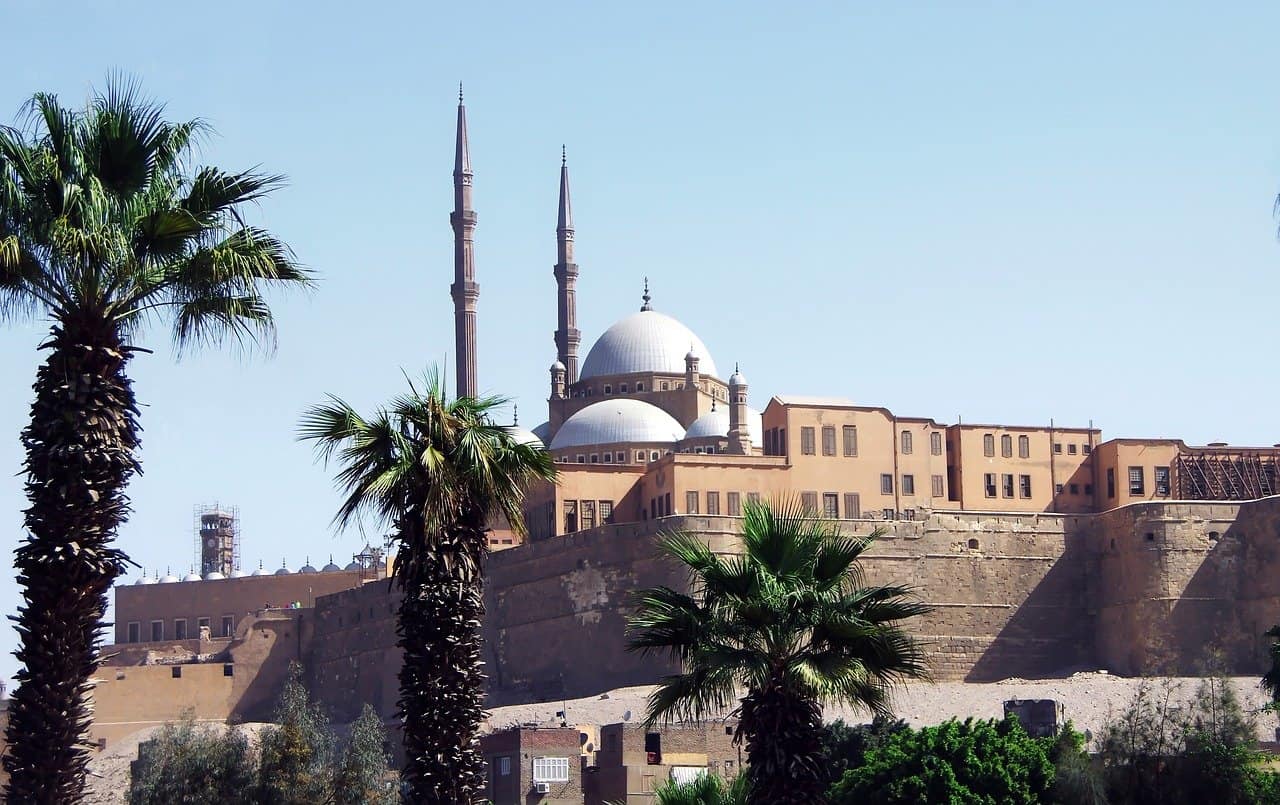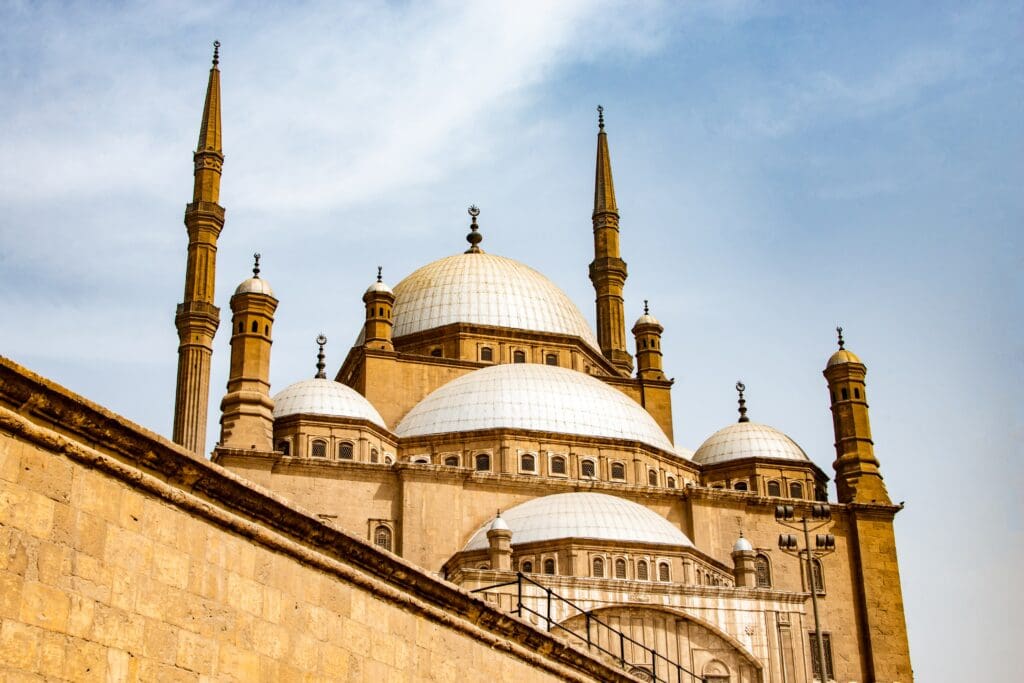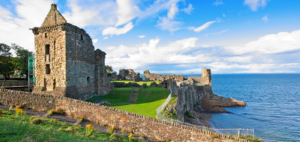Cairo Citadel in Cairo, Egypt

Updated On: April 16, 2024 by Yomna Salah
In Cairo, you can behold numerous signs of beauty and art. Egypt is full of exciting places to visit, making it one of the top destinations to learn about history and culture. Citadels and museums are all around Cairo City. One of the most significant fortifications is the Cairo Citadel. The locals may refer to it as Salah El-Din Citadel instead. This name refers to the builder who dates back to the Ayyubid reign and the Crusaders’ defeat.
A Glimpse About Cairo Citadel
Qala’at Salah El-Din is the Arabic name of Cairo Citadel. The fortification is a simple Islamic structure that sits on Mokattam Hill. It is considered to be close to the centre of the city. Its main objective has always been to provide visitors with splendid city views. Besides, it remains one of the pristine historic locations in Cairo City. Above and beyond, it embraces more than a few mosques and museums with history and many tales to unfold.
The castle sits on a higher level than the rest of the surrounding residences. Thus, it offers different views of Cairo and is equally superb. As part of the new Islamic world, it is now considered one of the top tourist destinations. UNESCO has always claimed it as part of the World Heritage Site of Historic Cairo.
Cairo Citadel Through The History
The primary purpose of building the Cairo Citadel was to avert the Crusaders’ attempts to invade the city. Thus, Salah El Din built this fortification in 1176 CE, intermingling the two towns of Fustat and Cairo. Fustat used to be an independent city that surrounded the castle. However, the two towns became one whole city upon constructing the fortification. Afterwards, an army was set up to fight enemies and protect the towns.
Salah El Din took the initiative of building the citadel right after he defeated the Fatimid Caliphate. He also chose a strategic location to erect the structure. Not only is it close to the city centre, but it also makes the attacking attempts even harder. Through many years, Cairo Citadel was the heart of the Egyptian government. It was only until the 19th century that it ceased being so after the arrival of Khedive Ismail. As the new ruler of Egypt then, he moved the government seat to Abdin Palace.
About Salah El Din Ibn Ayyub
As one of the strongest rulers of all time, Salah El Din was also popular among the European nations. He has always been known as Saladin. The influential leader was born in Iraq with the name Youssef, or Joseph. However, he was commonly known as Salah EL Din instead. Despite being born in Iraq, he spent his childhood in Damascus, Syria. He also died and was buried there.
Syria was famous for having numerous fortifications. Their primary purpose was to defend the country from the enemies’ attacks. Accordingly, Salah El Din carried that defensive custom to the lands of Egypt and built the Cairo Citadel.
The Construction of Cairo Citadel
What we see today is not the original form of the castle. When Salah El Din built it, the structure had rounded towers. Those towers were enormous, just as the walls that surrounded the citadel. The height of those walls made it hard for the attackers to get in. It was also impossible for them to climb up or penetrate through its thickness. This had proven back then that Salah El Din’s techniques were fruitful. However, the castle had undergone several renovations by the following rulers of Egypt.
Looking for the Perfect Site
According to historical sources, Salah El Din took some time to find the perfect location to build the castle. It was said that he roamed the city, searching for a site with fresh air that seemed relatively healthy. His attempts to figure this out included hanging pieces of fresh meat to check the freshness of the breeze. After having the meats spoiled in several areas, the area where Cairo Citadel is today was perfect. It was the only place where the beef stayed fresh for several days.
The Well of the Spiral
Salah El Din cared for supplying his people with their essential needs within Cairo Citadel. Accordingly, he built a well that was as deep as 280 feet to provide water. The well was known as the Well of the Spiral. That name came from the fact that it was made of around 300 stairs. They all went in a spiral down the inside of the well. Thanks to it, water finally began flowing into Cairo Citadel. These waters were raised to the surface and went through pipes around the area.
The Well of Joseph was another name for which the well was famous. According to some claims, Salah El Din’s real name was Youssef, the Arabic equivalent of Joseph. He was given that name at birth; thus, the well significantly received that name. The well remains one of the significant landmarks of the citadel to this day.
Building Water Wheels
Despite all the efforts of Salah El Din, the Well did not last for as long as it should have. It stopped functioning at some point through the years. The struggle continued until al-Nassir Muhammad pitched in and solved the problem during his reign. He wanted to make sure that those who lived within Cairo Citadel received a sufficient amount of water. Accordingly, he built a sound system with several water wheels to swell the volume of the water. The role of the wheels was to carry water from the Nile up to the walls. Then, it ran through pipes that Salah El Din previously constructed and reached the desired destinations.
Cairo Citadel Following The Death Of Salah El Din
As luck would have it, the death of Salah El Din did not put an end to the lives within the citadel. Cairo Citadel was usually taken care of by most of the rulers of Egypt. The rulers with the ultimate contributions to Cairo Citadel were Al-Nasir Muhammad Ibn Qalawun and Muhammad Ali Pasha. During their time in the supremacy, they renovated the citadel and significantly perked up life within it.
The Reign of al-Nasir Muhammed Ibn Qalawun
Al-Nasir Muhammad Ibn Qalawun was deemed to be one of the rulers who made significant contributions to the Cairo Citadel. One of his noteworthy achievements was providing the castle with sufficient water. On the other hand, he was also responsible for expanding and renovating the citadel. Ibn Qalawun completed the structure’s southern enclosure. Salah El Din only finished the northern part before he passed away. Moreover, Ibn Qalawun also constructed a residential area, including spaces for a courtyard and a harem. The latter was a Muslim household used only by females and existed during ancient times. In the Arab world, this word sometimes refers to a cluster of women.
Further contributions of Ibn Qalawun to Cairo Citadel include building a mosque. It was a memorial of his own where the mosque resonated his name. However, the structure of which the mosque lies has always been around since the Ayyubid. It was built in 1318 but for a different purpose. Since it was unused, Ibn Qalawun turned it into the Mosque of Al-Nasir. You can also find the House of Gold and the Hall of Justice within Cairo Citadel. While they were not credited to the accomplishments of Ibn Qalawun, they’d been around during his supremacy.
Muhammad Ali Pasha’s Contributions to The Cairo Citadel
Muhammad Ali Pasha escorted people to refer to Cairo Citadel by his name. That was after he built a mosque on the brink of the summit of the castle and gave his name to it. Even in Arabic, people sometimes call the Cairo Citadel Qala’at Muhammad Ali. Moreover, the mosque was built between 1828 and 1848. It was around during Muhammad Ali’s reign for some time, but no specific year was ever known. This mosque is a pure reflection of the Ottoman Style and culture, apparent in the architecture and the dome. Since it belonged to the Turkish culture, it had specific characterizations, including domes, semi-domes and ceramic tiles on the walls. You would also realize the presence of minarets that have pencil shapes.
Announcing His Supremacy
Muhammad Ali Pasha announced himself as the new ruler after he made several alterations to the Cairo Citadel. For example, he shifted the residential area to the northern enclosure instead of the southern. He was making sure that everything was different from how it was during the Mamluk Dynasty. Thus, he started by building structures reflecting Ottoman culture and style. After erasing everything that symbolized the previous dynasty, Cairo Citadel became famous for its Ottoman theme.
During his supremacy, he built two significant mosques. The one that sits on the summit of the castle. The other one was in memory of his son, Tusun Pasha, who died in 1816. He built the mosque in the same year in which his second son passed away. That was all after destroying almost every palace and building that belonged to the previous leaders and reigns. He created vast spaces where he could replace them with Ottoman structures. However, the Mosque of Al-Nasir Muhammad remains as it ever was. Muhammad Ali Pasha never took it down, making his own mosque the official state mosque of Cairo Citadel.
More Buildings Found Within Cairo Citadel
Cairo Citadel happens to embrace numerous buildings within its walls. Most of the structures are mosques built throughout different eras. However, not every building is a mosque, a lot of them happen to be museums. These museums include the Egyptian Military Museum, Al Gawhara Palace, and Carriage Museum. Concerning the mosques, we’ve already mentioned the existence of two prominent ones that belonged to Muhammad Ali and Ibn Qalawun. Besides those two mosques lies the first Ottoman-style mosque, the Suleyman Pasha Al Khadim Mosque.
The Egyptian Military Museum
Back in 1937, the Egyptian Military Museum was established. The building in which the museum lies formerly served a different purpose. When it was first constructed, it was the old Egyptian Ministry of War building. However, the original construction took place in Downtown Cairo. Several years later, they moved the building to an elite district in Cairo known as Garden City. Despite the numerous relocations, the Ministry of War only settled in the Haram Palace in Cairo Citadel. The building had gone through many renovations until it became the Egyptian Military Museum at the end.
The Egyptian Military Museum sits at sight level, where you can see it from any angle. Once you get through the wall of the Cairo Citadel, you can see signs that direct you to the desired places around the citadel. After getting to the Military Museum, it’s interesting to take the time to roam inside and see what it holds. The museum embraces numerous major exhibitions that all relate to the history of the Egyptian military. You can also find two calibre guns at both sides of the gate that date back to the time of Muhammad Ali Pasha. Most importantly, the museum has a sculpture of Salah El Din. It is deemed to be among the most prominent monuments inside the museum.
Al Gawhara Palace
Known with so many names include Qasr Al Gawhara, Bijou Palace, or simply Al Gawhara Palace. It lies near the mosque of Muhammad Ali Pasha, which was constructed by Muhammad Ali himself in 1814. Al Gawhara is an Arabic word that means Jewel or a Gem. This palace is among the prominent structures of Cairo Citadel that reveal an Ottoman theme. That was expected since Muhammad Ali Pasha originally made the construction. He exerted a great effort to make his culture the most dominant one within the citadel. And he succeeded in doing so.
Workers and artists who worked on constructing Al Gawhara Palace came from different places worldwide. That included countries like Greece, Bulgaria, Albania, Turkey, and others. They all pitched in to create such a masterpiece, using their cultural knowledge and skills. The palace has two different levels, and its windows are more Western-style than Turkish-style. It also has two sides, and each of them serves a purpose. One side embraced a reasonably large courtyard. However, the other side was left to behold the beautiful scene of the Nile and the Great Pyramids of Giza. Unfortunately, those scenes are no longer seeable, for the tall buildings that now flood the country.
The Internal Design of the Palace
Aside from the outer appearance of the palace, there is an audience hall inside. It was the spot where Muhammad Ali Pasha welcomed and met his guests. This hall also has a heavy chandelier that’s weight reaches up to almost a thousand kilograms. Louis-Philippe I of France was the one who had sent it as a gift to Muhammad Ali Pasha. The latter kept nearly all the gifts he received tucked into that audience hall. Other gifts included a throne sent by the King of Italy and other paintings that foreign ambassadors used to send him. Above and beyond, the palace also contains lavish areas, including a fascinatingly luxurious grand room. That room was usually used for entertainment, like chatting in a relaxing atmosphere or reading and playing music. There were also dancing activities that took place within that vast room.
Unfortunate Accidents that Took Place
After the construction of the building, the palace sat peacefully within Cairo Citadel for eight years. It was only in 1822 that an unfortunate event took place, turning the wooden construction into ashes. A fire broke in and remained still for two days, eating whatever it could. Muhammad Ali Pasha had to fix the flaws that caught the palace walls. Thus, he reconstructed the destroyed areas. Along with his reconstruction process, he complimented the palace by adding plants and floral lives on top of the stone terraces. Above and beyond, he also constructed a large marble fountain and added a petting zoo. In that zoo, he kept the animals that the British Lord Hastings used to send to him as gifts. Those animals included an elephant, two tigers, and a lion.
The palace contained gunpowder and other elements that were kept there. Two years after the incident, another fire broke in. But, at that time, the gunpowder explosions were to blame. The fire caused severe damage to the palace again. Those damages had escorted Muhammad Ali Pasha to import large pieces of marble from Italy. He used that marble piece to reconstruct the staircase, lobby, corridors, and other damaged areas.
Carriage Museum
Another museum is to be found within the walls of the Cairo Citadel. The Carriage Museum can be found in the northeastern part of the citadel. It is commonly known as the Royal Carriages Museum. The museum lies on the grounds of the Egyptian Military Museum. It is even more noticeable since the Military Museum is deemed to be a bit isolated. In front of it is the Mosque of Suleyman Pasha. According to many claims, this building, in particular, is the most visible around the Cairo Citadel. It’s not that the rest of the buildings are invisible, but the external design of this Museum makes it meaningful. This museum has been around since 1983. Today, we see the renovated structure that took place in 2013 and has remained so since then.
The museum has only one level, and the windows are all rectangular. Over each window, there is a miniature horse monument. Those elements contributed to making the museum noteworthy despite its isolation. Before becoming the Royal Carriage Museum, the building was where British Officers stayed. However, that was way back during the colonial period.
Possessions of the Carriage Museum
A wide array of collections of distinctive Royal carriages came into being through many historical spans. Interestingly, many of them can be found within the Royal Carriage Museum. The horses that sit above the windows are symbols of the carriages. Most of the materials the museum holds belong to the reigns of Khedive Ismail and King Farouk. History gurus know how long this span has lasted, which would pique their interest in learning even more.
The walls of the museum hold an incomparable collection of antiques. Most of them have some relation with the carriages that the museum presents. According to some sources, the antiques resided in the other Carriage Museum in Bulaq in Cairo.
Collections Found Inside
While the collections of the museums are not that big, they are all of great significance to history. Those collections are all eight in total. The carriages are maintained and still found in their original colours and paint. Four out of the eight carriages had known tales behind them. Starting from the golden state carriage it belonged to the era of Khedive Ismail. Most of them did belong to the era of Khedive Ismail. However, this golden one, in particular, was a gift that Khedive Ismail received from Napoleon III.
Another significant carriage was a huge black one you get to see as soon as you enter the museum. Despite its dark colour, it has red highlights and served to welcome the kings and queens who came to visit. One of the remaining two is quite huge, while the other happens to be moderate in size. The moderately sized one belonged to Ahmed Fouad Pasha. He used that carriage as a means of transport. On the other hand, the vast carriage was used during the opening of the Suez Canal. It served the foreign royalty and welcomed them upon their arrival in Egypt to celebrate the canal opening.
The Mosque of Suleyman Pasha al-Khadim
Here, we go back to the presence of a mosque within the Cairo Citadel rather than museums. This one is lovely. It sits in the northern part of the citadel and has been around since the Fatimid dynasty. It is also one of the first Ottoman mosques in Egypt. The Governor of Alexandria built the mosque. He was Abu Mansour Qastah Ghulam al-Muzaffar ibn Amir al-Juyush.
The façade on the southwestern part contains a minaret and a square base with diagonal corners. However, like most of the other buildings of Cairo Citadel, the mosque had gone through several makeovers. Soleyman Pasha revamped the old mosque when it appeared to wane and crack. The mosques of Istanbul inspired him; thus, he used the Ottoman style to revamp the mosque. This makes it one of the oldest mosques in Egypt, reflecting the Ottoman style.
Monuments Of Cairo Citadel

There are more surprises to Cairo Citadel than you can imagine. The area is big enough to hold mosques, museums, and other monuments. You’ll find a wide array of monuments that range from weapons of an old era to statues of known figures. In those empty paths between the buildings lie monuments with stories to tell. You will enjoy learning about them as much as exploring the surrounding buildings.
The Egyptian Soldier Photo
The grounds of the Egyptian Military were once within the vast walls of Cairo Citadel. Thus, you can expect to find a story or two about soldiers. In this case, it is a photo of an Egyptian soldier found on the walls of the Egyptian Military Museum. The image displays a soldier who holds a child and an attached phrase at the bottom. That phrase is in Arabic and reads, “The army and the people are united.” There are no further descriptions around the photo, but Egyptians still use this phrase to express unity.
Muhammad Ali Pasha’s Weapons and More
As previously mentioned, Cairo Citadel has more than a few weapons and gunpowder elements. That was once the reason some buildings were set on fire. You can see weapons on display between the hallways. Many of the guns that Cairo Citadel houses belonged to Muhammad Ali Pasha or, at least, dated to his reign. There are numerous canons in exhibitions in the open courtyard inside one of the museums. On the other hand, one of the canons that dates back to the reign of Muhammad Ali Pasha stands on its own. Among Muhammad Ali Pasha’s belongings are two amphibious transporters and a mortar. The former were proved to be helpful during the war of 1973. They moved the soldiers from one place to another, providing them with the needed defence.
Other Weapons
Other than the weapons that belong to Muhammad Ali Pasha’s supremacy, others don’t. Not all of them are specified to specific dates; however, some of them are. Among those other weapons is the British Armstrong Gun. It dates back to 1846 and was used for defending the country’s coasts.
That gun and two other coastal defence guns are displayed inside Cairo Citadel. Those other two are in the background of the Mosque of Al-Nasir Muhammad Ibn Qalawun. There is also one more gun of Russian origin. It was another one used to defend the coast, seemingly needing constant protection. The gun was also used in the war that took place back in 1967. Interestingly, you can also see the weapons that soldiers used during World War I. It’s a collection of German Pipe guns and British Naval Guns. There is also a Kerop Field Gun that is actually of German origins.
Tanks and Aircrafts
Aside from the apparent weapons that Cairo Citadel showcases, there are aircraft jets and military tanks. The Citadel houses everything related to the military and the elements used in wars. That makes it one of the exciting destinations in Cairo to observe things that once played a role in history. There are several missiles and fighter jets on display. They were all manufactured by Russians. Numerous tanks belong to the Egyptian military. However, only one of those tanks happens to be Russian. The Egyptian army received that Russian tank back in 1955.
Statues of Prominent Figures
You expected to find statues among the vastness of Cairo Citadel, right? There are numerous spaces and hallways between the buildings, which were perfect spots for placing weapons and statuses of prominent figures. Cairo Citadel houses over a dozen statuses of historic characters. Each of them had a story and a significant role in Egyptian history. So, let’s learn about the statues you can expect to see there.
Salah El Din Ibn Ayyub
The one who built this fortress had to be honoured and forever remembered. Cairo citadel houses a statue that portrays Salah El Din, the Crusaders’ defeater. Displayed in a prominent spot, he’s described as one of the most powerful rulers in history. He ruled Egypt for around two decades.
Muhammad Ali Pasha
Here’s one more whose statue should be around: Muhammad Ali Pasha. Since his ultimate contributions to Cairo citadel, it was essential to have a statue. Muhammad Ali Pasha was behind the magnificent Ottoman-style buildings we see in Egypt. He also ruled Egypt for over four decades, shaping a great deal of its history. Moreover, there is one more statue of his within the walls of the fortress. That is wholly portrayed, displaying him holding a sword while standing tall and strong. Near his statue lies a small cafeteria that serves people delicious snacks.
Ibrahim Pasha
Ibrahim Pasha Statue lies within the fortress. He comes from the same family as Muhammed Ali. He was the eldest of all of his sons. The Statue stands in a place that provides a captivating scenery. It overlooks the brilliant silver dome of the Mosque of Muhammad Ali Pasha. You can also see the green dome of the Mosque of Al-Nasir Muhammad from where the statue stands.
Baibars the Mamluk Sultan
Baibars ruled Egypt for many years, from 1260 to 1277. There is a statue of that influential leader in Cairo Citadel. His real name was Rukn El Din Baibars. However, he was famous for his last name, as it was more commonly used.
Statues of the Egyptian Pharaohs
Seemingly, Cairo Citadel has been around since the supremacy of Salah El Din Ibn Ayyub. It happens to house buildings from that era as well. However, some weapons and aircraft missiles return to some older times. Above and beyond, the statues it holds all belonged to people since the era of Salah El Din and the following eras. The only older thing it houses is a collection of statues that belong to people from ancient Egypt. Most of those figures were from the era of the Pharaohs. They played the ultimate role in shaping Egyptian history and building its civilization.
Those statues include one for Ramses II, one of the most outstanding leaders in Ancient Egyptian history. He ruled Egypt for many years. Another statue displays the Pharaoh King, who unified Egypt during Ancient times. He was famous as Narmer, although his real name was Menes. There are also two more statues of Egyptian Pharaohs. One belongs to Tuthmosis III, who ruled Egypt between 1479 and 1425 BC. The other belongs to King Ahmos, who was in power from 1539 BC until 1514 BC.






